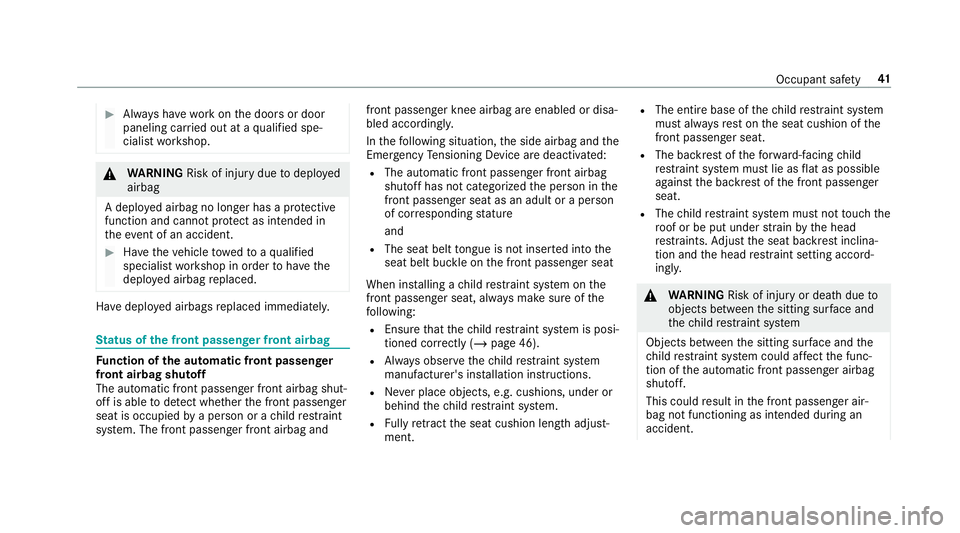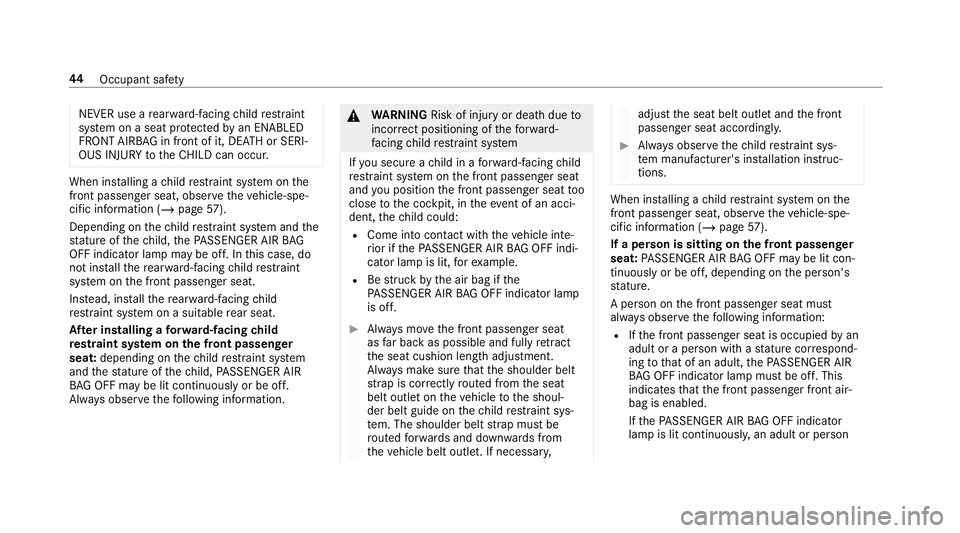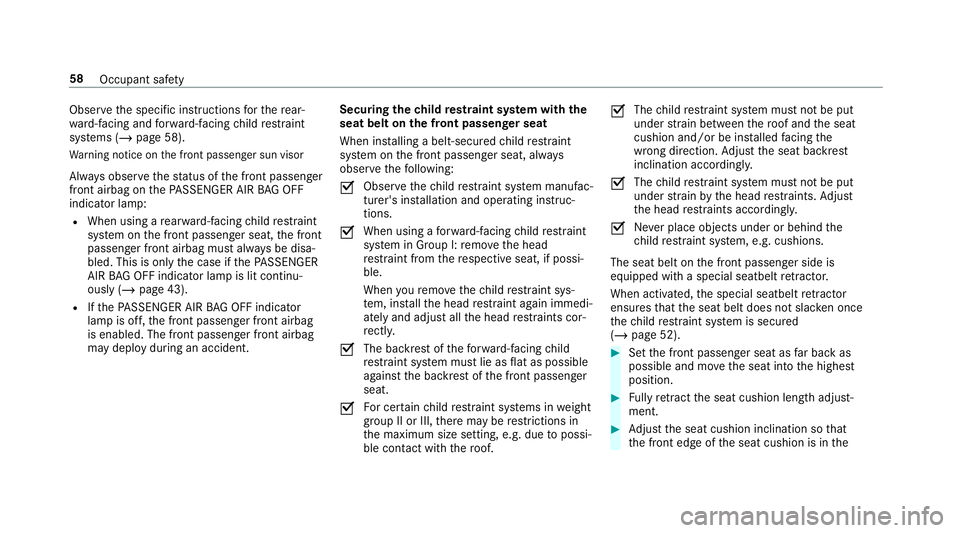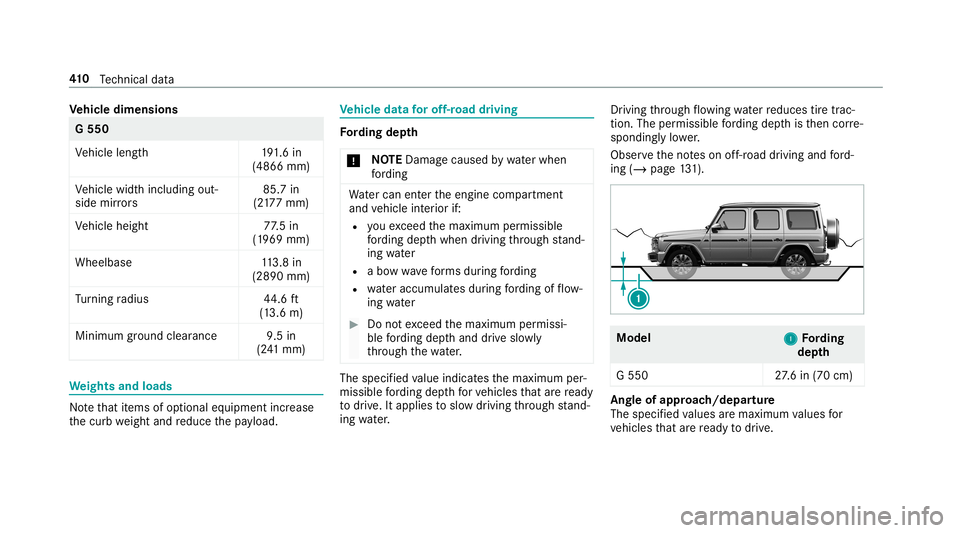2019 MERCEDES-BENZ G-CLASS length
[x] Cancel search: lengthPage 43 of 514

#
Alw aysha ve wo rkon thedoor sor door
paneling carried out ataqu alif ied spe‐
cialis two rkshop. &
WARNIN GRisk ofinju rydue todeplo yed
airbag
A deplo yedairbag nolong erhas apr otect ive
func tion andcann otprotect asintended in
th eev ent ofan acciden t. #
Have theve hicle towe dto aqu alif ied
spec ialistwo rkshop inorder tohave the
deplo yedairbag replaced. Ha
ve deplo yedairbags replaced immediat ely. St
atus ofthefront passeng erfront airbag Fu
nction oftheaut oma ticfront passeng er
fr ont airbag shutoff
The automatic front passeng erfront airbag shut‐
of fis able todetect whe ther thefront passeng er
seat isoccupied byaper son orach ild restra int
sy stem. Thefront passeng erfront airbag and fr
ont passeng erknee airbag areenabled ordisa‐
bled accor dingly.
In thefo llo wing situat ion,theside airbag andthe
Emerg encyTensi oni ng Device arede acti vated:
R The automatic front passeng erfront airbag
shut offhas notcat egor ized theper son inthe
fr ont passeng ersea tas an adu ltor aper son
of cor responding statur e
and
R The seat belttongu eis no tins ertedint oth e
seat beltbuckleonthefront passeng erseat
When installing ach ild restra int system onthe
fr ont passeng ersea t,alw aysmak esur eof the
fo llo wing:
R Ensur eth at thech ild restra int system isposi‐
tion edcor rectl y(/ page 46).
R Alw aysobser vethech ild restra int system
manuf acturer'sinstallation instruct ions .
R Neverpla ceobjects, e.g.cushi ons,under or
behi ndthech ild restra int system.
R Fully re tract theseat cushion lengthadjus t‐
ment . R
The entire base ofthech ild restra int system
mus talw aysre st on theseat cushion ofthe
fr ont passeng ersea t.
R The backres tof thefo rw ard-f acin gch ild
re stra int system mus tlie asflat as poss ible
ag ains tth ebac kres tof thefront passeng er
seat.
R The child restra int system mus tno tto uc hth e
ro of or be put under stra in by thehead
re stra int s.Ad jus tth eseat backres tinclin a‐
tion andthehead restra int setting accord‐
ing ly. &
WARNIN GRisk ofinju ryor deat hdue to
object sbe tween thesitt ing surface and
th ech ild restra int system
Objec tsbetween thesitt ing surface and the
ch ild restra int system could affect thefunc ‐
tion oftheaut omatic front passeng erairbag
shut off.
This could result inthefront passeng erair‐
bag notfunc tioningasintended during an
acciden t. Occ
upant safety 41
Page 46 of 514

NEVER
useare ar wa rd-faci ng child restra int
sy stem onaseat protect edbyan ENABLED
FR ONT AIRB AG infront ofit,DE ATHor SERI‐
OUS INJURYtotheCH ILD can occur . When
installing ach ild restra int system onthe
fr ont passeng ersea t,obse rveth eve hicle-spe‐
cif icinf ormation (/page57 ).
De pend ing on thech ild restra int system and the
st atur eof thech ild, thePA SSENGER AIRBAG
OFF indicat orlam pma ybe off.In this case, do
no tins tallth ere ar wa rd-faci ng child restra int
sy stem onthefront passeng erseat.
Ins tead, installth ere ar wa rd-faci ng child
re stra int system onasuit able rear seat .
Af terin st alli ng afo rw ard-f acin gch ild
re stra int system onthefront passeng er
seat :depen dingonthech ild restra int system
and thest atur eof thech ild, PASSENGER AIR
BA GOF Fma ybe litcon tinuousl yor be off.
Alw aysobser vethefo llo wing informatio n. &
WARNIN GRisk ofinju ryor deat hdue to
inc orrect pos itioning ofthefo rw ard-
fa cing child restra int system
If yo usec ureach ild inafo rw ard-f acin gch ild
re stra int system onthefront passeng erseat
and youposi tionth efront passeng erseat too
clos eto thecoc kpit, intheeve ntofan acci ‐
de nt, thech ild could:
R Come intocon tact with theve hicle inte‐
ri or ifth ePA SSENGER AIRBAGOF Find i‐
cat orlam pis lit,fo rex am ple.
R Bestru ck bytheair bag ifth e
PA SSENGER AIRBAGOF Find icat orlam p
is off. #
Alw aysmo vethefront passeng erseat
as farbac kas possi bleand fully retract
th eseat cushion lengthadjus tment.
Alw aysmak esur eth at theshoulder belt
st ra pis cor rectly routed from theseat
belt outle ton theve hicle totheshoul‐
der belt guide onthech ild restra int sys‐
te m. The shou lderbeltstra pmus tbe
ro uted forw ards and down wardsfrom
th eve hicle beltoutle t.Ifnecessar y, adjus
tth eseat beltoutle tand thefront
passeng erseat accor dingly. #
Alw aysobser vethech ild restra int sys‐
te m manuf acturer'sinstallation instruc‐
tion s. When
installing ach ild restra int system onthe
fr ont passeng ersea t,obse rveth eve hicle-spe‐
cif icinf ormation (/page57 ).
If aper son issit tin gon thefront passeng er
seat :PA SSENGER AIRBAGOF Fma ybe litcon ‐
tin uousl yor be off,depen dingon theper son's
st atur e.
A per son onthefront passeng erseat must
alw aysobser vethefo llo wing informatio n:
R Ifth efront passeng erseat isoccupied byan
adult oraper son withast atur ecor respond‐
ing tothat ofan adult ,th ePA SSENGER AIR
BA GOF Find icat orlam pmus tbe off.This
ind icat esthat thefront passeng erfront air‐
bag isenabled.
If th ePA SSENGER AIRBAGOF Find icat or
lam pis lit con tinuousl y,an adult orper son 44
Occupant safety
Page 60 of 514

Obser
vethespecif icins truction sfo rth ere ar‐
wa rd-faci ng and forw ard-f acin gch ild restra int
sy stems (/page58).
Wa rning notic eon thefront passeng ersun visor
Alw aysobser vethest atus ofthefront passeng er
fr ont airbag onthePA SSENGER AIRBAGOF F
ind icat orlam p:
R When usingare ar wa rd-faci ng child restra int
sy stem onthefront passeng erseat, thefront
passeng erfront airbag mustalw aysbe disa‐
bled. Thisisonl yth ecase ifth ePA SSENGER
AIR BAGOF Find icat orlam pis lit con tinu‐
ousl y(/ page43) .
R Ifth ePA SSENGER AIRBAGOF Find icat or
lam pis off,th efront passeng erfront airbag
is enabled. Thefront passeng erfront airbag
ma ydeplo ydur ing anacciden t. Secur
ingthe child restra int system withth e
seat beltonthefront passeng erseat
When installing abelt- secur edchild restra int
sy stem onthefront passeng erseat, always
obser vethefo llo wing:
0073 Obser
vethech ild restra int system manuf ac‐
tur er's installation andopera tingins truc‐
tion s.
0073 When
usingafo rw ard-f acin gch ild restra int
sy stem inGroup I:re mo vethehead
re stra int from there spectiv eseat, ifpossi‐
ble.
When youre mo vethech ild restra int sys‐
te m, installth ehead restra int again immed i‐
at elyand adjus tall thehead restra int scor ‐
re ctl y.
0073 The
backres tof thefo rw ard-f acin gch ild
re stra int system mus tlie asflat as poss ible
ag ains tth ebac kres tof thefront passeng er
seat.
0073 Fo
rcer tain child restra int systems inwe ight
gr ou pIIor III, th er ema ybe restrictions in
th emaximum sizesetting, e.g. due topossi‐
ble con tact with thero of. 0073
The
child restra int system mus tno tbe put
under stra in be tween thero of and theseat
cushion and/orbeinstalled facing the
wr ong direct ion. Adjus tth eseat backres t
inclin ation accordingly.
0073 The
child restra int system mus tno tbe put
under stra in by thehead restra int s.Ad jus t
th ehead restra int sacc ording ly.
0073 Ne
verpla ceobjects underorbehi ndthe
ch ild restra int system, e.g.cushions .
The seat beltonthefront passeng erside is
eq uipped withaspecial seatbelt retract or.
Wh enacti vated, thespecial seatbelt retract or
ens ures that theseat beltdoes notslac kenonce
th ech ild restra int system issecur ed
(/ page52). #
Setth efront passeng erseat asfarbac kas
possi bleand movetheseat intoth ehighes t
position . #
Fully re tract theseat cushion lengthadjus t‐
ment . #
Adjus tth eseat cushion inclination sothat
th efront edgeof theseat cushion isin the 58
Occupant safety
Page 177 of 514

Ve
hicles withAc tivePa rking Assistand a360 °
Camer a
If Ac tivePa rking Assistis deact ivat ed and an
obs tacle isde tected inthepat hof theve hicle, a
pop-up windowforPa rking AssistPA RK TRONI C
1 appear sin themultimedia system atspeeds
belo w6mp h(1 0 km/h).
Sy stem limita tions
Pa rking AssistPA RK TRONI Cdoes notne cessa‐
ri ly take intoacc ount thefo llo wing obstacle s:
R Obs tacle sbel ow thede tection rang e, e.g .
pe rsons, animals orobject s. R
Obs tacle sab oveth ede tection rang e, e.g .
ove rhang ingloads, overhang sor loadin g
ra mp sof truc ks.
The sensor smus tbe free ofdir t,ice and slush.
Ot her wise, they ma yno tfunction correctly .
Cl ea nth esensor sre gular ly,especially afte rdr iv‐
ing off-r oad ,ta king careno tto scr atc hor dam‐
ag eth em.
Ve hicl eswith traile rhitc h:Parking Assist
PA RK TRONI Cis deac tiva tedfo rth ere ar zone
when youes tablish anelect rical connecti on
be tween your vehicle andatrailer .
Fu nction ofthepa ssiv eside impact protec‐
tion
Pa ssiv eside impact protect ion isan additional
Pa rking AssistPA RK TRONI Cfun ction whic h
wa rnsth edr iver about obstacle sat theside of
th eve hicle. Awa rning isissued whenobstacle s
ar ede tected between thefront and rear detec‐
tion rang e. In orde rfo ran object tobe detected,
th esensor sin thefront and rear bum permus t
de tect theobjec twhile youar edr ivin gpas tit.
Dur ing thepar king procedur eor maneuv ering,
objec tsarede tected astheve hicle drives pas t. If
yo usteer inthedir ect ion ofade tected obs ta‐
cle and ther eis arisk ofalat eral collision, a
wa rning isissued. Thelateral segme ntslight up
or ang eor red, dependin gon thedis tance tothe
obs tacle .
Seg ment colordepe ndingon distan ce
Co lor Lateral dis tan cein
cm
Re dA pprox.< 30
Or ang eA pprox30 -60 In
order forlat eral front orrear segm entsto be
displa yed, theve hicle mustfirs ttr ave la dis tance
of at leas tha lfof theve hicle length.Once the
ve hicle hastrave led thelengt hof theve hicle, all
of thelat eral front and rear segm entscan bedis‐
pla yed. Dr
iving andparking 17
5
Page 390 of 514

th
ese areins talled ontheve hicle, butdoes not
include passeng ersor lugg age.
Maximum tireload: themaximum tireload is
th emaximum permissible weight inkilog rams or
lbs forwhi chatir eis appr oved.
Maxim umpermissible tirepr essur e:maxi‐
mum permissible tirepr essur efo rone tire.
Maximum loadonone tire: maximu mloa don
one tire. This iscalcu lated bydividing themaxi‐
mum axleload ofone axle bytwo.
PSI (pounds persquar ein ch ):standar dunit of
meas uremen tfo rtir epr essu re.
Aspe ctratio :ra tio betwee ntire height and tire
wi dthin pe rcent .
Ti re pres sur e:press ureinsi dethetir eappl ying
an outw ardfo rc eto eve rysquar einc hof thetir e.
The tirepr essur eis specif iedinpounds per
sq uar einc h(psi), inkilopascals (kPa)or inbar .
The tirepr essur eshould onlybe cor rected whe n
th etir es arecold.
Cold tirepr essur e:thetir es arecold when the
ve hicle hasbeen parkedfo rat lea st3hou rs wit
hout direct sunli ghtonthetir es ortheve hicle
has been driven forless than 1mile (1.6 km ).
Ti re contact surface: thepar tof thetir eth at
com esintocon tact with thero ad.
Ti re bead: thepur pose ofthetir ebead isto
ensur eth at thetir esits secur elyon thewheel
ri m. Ther ear ese veralwir ecor esinthetir ebead
to preve ntthetir efrom chang inglengthon the
wheel rim.
Side wall:thepar tof thetir ebe tween thetread
and thetir ebead.
We ight ofoptiona leq uipm ent:th ecombin ed
we ight oftheop tion aleq uipment weighin gmor e
th an there placed standar dpar tsand moreth an
5 lbs (2.3kg ).This optional equipment, suchas
high-per form anc ebr ak es, leve lcon trol system, a
ro of lugg agera ck orhigh-per form anc ebat teries,
is no tincluded inthecurb weight andthewe ight
of theaccessor ies.
TIN (Tire Identif ication Numbe r):auni que
ident ificat ion numb erwhic hcan beused bya
tir ema nuf actu rerto ident ifytires, forex am ple,
in apr oduc tre cal l,and thus iden tifyth epur‐
ch aser s.The TINismade upofthemanuf actur‐ er's
identit ycode, tiresize, tiretype code and
th emanuf acturingdate.
Load-bear inginde x:theload-bear inginde xis a
code that con tains themaximum load-bearing
capacity ofatir e.
Tr actio n:traction isthegr ip resulting from fric‐
tion between thetir es and thero ad sur face.
We arindi cator:nar row bars(tr ead wearbar s)
th at aredis tribut edove rth etir econ tact surface.
If th etir etread isleve lwit hth ebar s,thewe ar
limit of1/ 16 in(1.6 mm) hasbeen reac hed.
Dis tribut ionofvehicl eoc cupants: distribu tion
of vehicle occupants over designat edseat posi‐
tion sin ave hicle.
Maximum permissible payload weight :nom i‐
nal load andluggageload plus150lb (68 kg)
multip liedby thenumber ofseats intheve hicle. 388
Wheels andtires
Page 412 of 514

Ve
hicl edimens ions G
550
Ve hicle length1 91.6 in
(486 6mm)
Ve hicle widthincluding out‐
side mirrors 85.7
in
(2 17 7mm)
Ve hicle height 77.5 in
(1 969 mm)
Whe elba se 113.8 in
(2890 mm)
Tu rning radius 44.6ft
(1 3.6 m)
Minimum ground clearance 9.5in
(2 41 mm) We
ight sand loads No
tethat items ofoptio nal equipme ntinc rease
th ecurb weight andreduce thepa yload. Ve
hicl edata forof f-r oad drivin g Fo
rding dep th
* NO
TEDama gecau sed bywaterwhen
fo rd ing Wa
tercan entertheengine compartmen t
and vehicle interior if:
R youexc eed themaximum permissible
fo rd ing dep thwhen drivin gth ro ugh stand‐
ing water
R abo wwav efo rm sdur ing ford ing
R wateraccumu lates dur ing ford ing offlow ‐
ing water #
Donotexc eed themaximum permissi‐
ble ford ing dep thand drive slo wly
th ro ugh thewa ter. The
specif iedvalue indic ates themaximum per‐
missible ford ing dep thforve hicles that arere ady
to drive. Itapplies toslo wdriving thro ugh stand‐
ing water. Dr
iving thro ugh flow ing waterre duces tiretra c‐
tion .The permissible ford ing dep thisthen cor re‐
sponding lylowe r.
Obser vetheno teson off-r oad driving andford ‐
ing (/ page13 1). Mo
del
1 1
Fording
dep th
G 55 02 7.6 in (70 cm) Ang
leof appr oach/depar ture
The speci fied values aremaxim umvalues for
ve hicles that arere ady todrive. 41
0
Tech nica lda ta
Page 507 of 514

Tr
ip odom eter
see Trip dis tance
Tu rn signal indicat or
see Turn signals
Tu rn signals ..............................................1 10
Swi tching on/of f<0011001100110011001100110011001100110011001100110011001100110011
0011001100110011001100110011001100110011001100110011001100110011
00110011> 110
Tw oph one mod e
see Second telephon e
Tw o-w ayradio s
Fr eq uencies ......................................... 400
No teson installation ...........................3 99
Tr ans miss ionoutput (max imum ).........4 00 U
Un its ofmeas urement
Se tting .................................................2 42
Un loc king setting ...................................... 63
USB devices
Conn ecting .......................................... 304
USB port...................................................1 06
Use rpr ofile ....... ....................................... 244
Cr eat ing .......................................... .....2 44
Im por ting/e xporting ............................ 244 Op
tions .......................................... ...... 245
Se tting <0011001100110011001100110011001100110011001100110011001100110011
0011001100110011001100110011001100110011001100110011001100110011
0011001100110011001100110011001100110011001100110011001100110011
0011> 244
Using thete lephone
see Calls V
Ve hicl e...... ................................................ 127
Ac tivati ng/d eactiv ating standb y
mode .............................................. .....1 58
Cor rect use <0011001100110011001100110011001100110011001100110011001100110011
001100110011001100110011001100110011001100110011> ................24
Dam agede tection (parking) ................ 157
Dat aacq uisitio n............. ....................... 26
Dat ast or ag e .......................................... 26
Diagnos ticsconn ection .................. .......2 3
Eq uipme nt............. .......................... ......20
Li mit edWarrant y...................................2 5
Loc king (from theinside) ............... ........ 67
Loc king/unloc king(emerg encykey) .....6 8
Lo we ring <0011001100110011001100110011001100110011001100110011001100110011
0011001100110011001100110011001100110011> <0011001100110011001100110011001100110011001100110011001100110011
001100110011>396
Ma intena nce <0011001100110011001100110011001100110011001100110011001100110011
0011001100110011001100110011001100110011> ................21
Pa rking foran extende dpe riod ............ 157
Pr oblem notification ........................ ...... 25
QR code rescue card..................... ........ 26
Quali fied specialis two rkshop ................2 4
Ra ising ................................................ 393 St
andb ymode function ........................ 157
St artin g(eme rgency operation
mode) .................................................. 127
St artin g(sta rt/s topbutt on) .................1 27
Swi tching off(s ta rt/s topbutt on) ........ 149
To wing .................................................2 00
Un loc kin g(fr om theinside) .................... 67
Ve ntil ating (co nve nience openi ng) ......... 70
Vo ice com mand s(V oice ControlSy s‐
te m) ..................................................... 225
Ve hicl edata
Ang leof app roac h/d epar ture.............. 410
Dis play ing (DYN AMI CSE LECT) ............ 137
Fo rding dep th<0011001100110011001100110011001100110011001100110011001100110011
0011001100110011001100110011001100110011001100110011001100110011
001100110011001100110011> 410
Maximum gradient-climbing capabil‐
ity ........................................................ 410
Minimum ground clearance ................. 409
Tr ans ferring toAndr oid Au to™ ............ 288
Tr ans ferring toApp leCa rPlay™ ........... 288
Tu rning circle .......................................4 09
Ve hicle height ...................................... 409
Ve hicle length...................................... 409
Ve hicle width....................................... 409
We ight s................................................ 410
Wheelbase ...........................................4 09 Inde
x505